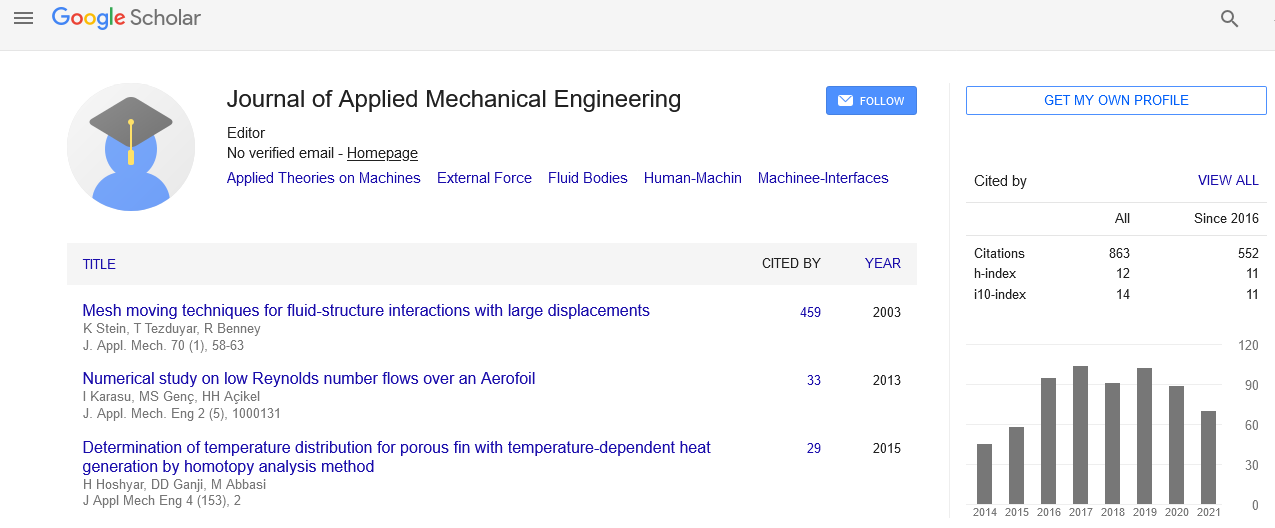Indexed In
- Genamics JournalSeek
- JournalTOCs
- CiteFactor
- RefSeek
- Hamdard University
- EBSCO A-Z
- OCLC- WorldCat
- Publons
- Google Scholar
Useful Links
Share This Page
Journal Flyer

Open Access Journals
- Agri and Aquaculture
- Biochemistry
- Bioinformatics & Systems Biology
- Business & Management
- Chemistry
- Clinical Sciences
- Engineering
- Food & Nutrition
- General Science
- Genetics & Molecular Biology
- Immunology & Microbiology
- Medical Sciences
- Neuroscience & Psychology
- Nursing & Health Care
- Pharmaceutical Sciences
Commentary - (2023) Volume 12, Issue 1
Additive Manufacturing: A Revolutionary Technology for Design Flexibility and Customized Production
Ravi Ayajiv*Received: 02-Jan-2023, Manuscript No. JAME-23-20845; Editor assigned: 05-Jan-2023, Pre QC No. JAME-23-20845 (PQ); Reviewed: 19-Jan-2023, QC No. JAME-23-20845; Revised: 26-Jan-2023, Manuscript No. JAME-23-20845 (R); Published: 03-Mar-2023, DOI: 10.35248/2168-9873.23.12.464
Description
The industrial revolution started with steam-powered machines and provided a reliable and continuous source of power to the industries, has crossed three generations of industrial advancements. The second major development in the industry was the electrically run mass production assembly lines which changed the course of the world and mankind as a whole. The third breakthrough in the segment was the introduction of computer-automated machines which further enhanced the speed, accuracy and reliability of the production many folds. Many thinkers thought about the next breakthrough and here we are in the new generation of Industry 4.0. It's the digital enterprising of the industry and is a collective term for the Internet of Things (IoT) based on Cyber Physical System (CPS).
AM is a process of creating a three-dimensional object by joining the materials. Though relatively a new technique and still in the phase of evolving, AM is projecting towards a profound era of manufacturing with its inherent advantages of design flexibility, reduced energy utilization and shorter lead time. The evolution of this technology is picking pace as it has progressed from Rapid Prototyping to the production of end-use parts directly.
The range of materials and their penetration in the industry is increasing in top gear. Additive Manufacturing (AM) is a collective term for the technologies in which complex geometries are manufactured directly from the Computer Aided Design (CAD) models using printers and without conventional tooling. The main advantage of this type of manufacturing apart from being off the shop floor is the most complex shapes can be manufactured. This feature gives another dimension to the designers to think and design new concepts without worrying about manufacturing constraints. It has given the flexibility to manufacture a range of products which nobody could imagine manufacturing just 40 years ago. Additive Manufacturing is also known as Solid Free Form Manufacturing (SSF), 3D printing, Rapid Manufacturing (RM), and desktop manufacturing.
Additive Manufacturing offers possibilities for small series production of customized products and increased freedom of design, due to the lack of tools. Thus this technique can help in identifying the basic faults that are expensive to be corrected later by creating prototypes to be tested. Additive Manufacturing is defined as the process of joining materials to make objects from 3D model data, usually layer upon layer, as opposed to subtractive manufacturing methodologies. As the definition suggests, it's a manufacturing process in which the physical models are fabricated by adding the material layer by layer taking a bottom to top approach until the whole geometry is ready. The different technologies of additive manufacturing can be divided into different categories based on the material used as the cartridge, binding mechanisms and the heat source used among others. Vat polymerization technique of additive manufacturing essentially requires a vat of liquid resin, which must be a photosensitive polymer. This resin is spread on the table one layer at a time and a focused Ultra Violet (UV) light is moved selectively on top of the layer. The UV light hardens the resin at the point of interaction thus forming a single layer at a time. The platform is then made to lowers down equal to the layer thickness and the second layer of resin is spread on top of the previously cured layer.
Conclusion
The whole process is repeated unless the complete threedimensional object is created. The advantage of this method is no structural supports are required. The standard commercial forms of this technology are Stereo Lithography, Digital Light Processing (DLP) and LCD 3D printer. The materials which can be used in this technology can be polymers and plastics. To achieve this phenomenon, the previous layers need to be cured so that they become hard and available for the next jet of material. Ultra Violet (UV) light is normally used to achieve the desired hardness. The material may be jetted on the stage in either Drop by Drop (DOD) mechanism or continuously. The cured resin is comparatively hard but the uncured material is soft and semiliquid thus additional support material is required in this technique.
Citation: Ayajiv R (2023) Additive Manufacturing: A Revolutionary Technology for Design Flexibility and Customized Production. J Appl Mech Eng. 12:464.
Copyright: © 2023 Ayajiv R. This is an open-access article distributed under the terms of the Creative Commons Attribution License, which permits unrestricted use, distribution, and reproduction in any medium, provided the original author and source are credited.

